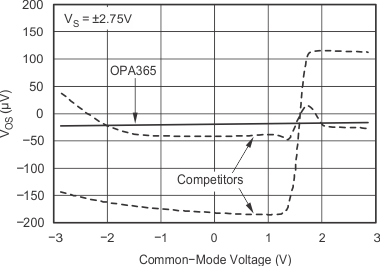SBOS365G may 2006 – may 2023 OPA2365 , OPA365
PRODUCTION DATA
- 1
- 1 Features
- 2 Applications
- 3 Description
- 4 Revision History
- 5 Device Comparison Table
- 6 Pin Configuration and Functions
- 7 Specifications
- 8 Detailed Description
- 9 Application and Implementation
- 10Device and Documentation Support
- 11Mechanical, Packaging, and Orderable Information
Package Options
Mechanical Data (Package|Pins)
- D|8
Thermal pad, mechanical data (Package|Pins)
Orderable Information
8.3.1 Rail-to-Rail Input
The OPAx365 product family features true
rail-to-rail input operation, with supply voltages as low as ±1.1 V
(2.2 V). A unique zerø-crossover input topology
eliminates the input offset transition region typical of many rail-to-rail,
complementary stage operational amplifiers. This topology also allows the OPAx365 to
provide excdellent common-mode performance over the entire input range, which
extends 100 mV beyond both power-supply rails, as shown in Figure 8-1. When driving ADCs, the highly linear VCM range of the OPAx365 makes
sure that the op amp or ADC system linearity performance is not compromised.
 Figure 8-1 OPA365 Linear Offset Over the Entire Common-Mode Range
Figure 8-1 OPA365 Linear Offset Over the Entire Common-Mode RangeFor a simplified schematic illustrating the rail-to-rail input circuitry, see Section 8.2.